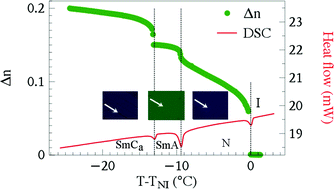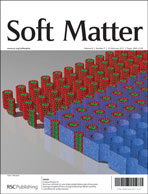Structure–property correlation of a hockey stick-shaped compound exhibiting N-SmA-SmCa phase transitions
Abstract
We report the measurement of birefringence, dielectric constant, splay, bend elastic constants and rotational viscosity in the nematic phase (N) of a hockey stick-shaped compound exhibiting smectic-A (SmA) and anticlinic smectic-C (SmCa) phase transitions at lower temperature. It is found that the physical properties are significantly different than calamitics and partially similar to the bent-core liquid crystals. It exhibits the positive dielectric and the negative elastic anisotropy. The optical and the thermal measurements show that all the transitions are first order. The rotational viscosity is comparatively higher than calamitic liquid crystals and exhibits weak pre-transitional divergence. The temperature dependent static dielectric measurements indicate antiparallel correlation of both the longitudinal and the transverse components of dipole moments in both the smectic phases. The parallel component of the dielectric constant exhibits a single Debye type relaxation in all the phases. The


 Please wait while we load your content...
Please wait while we load your content...